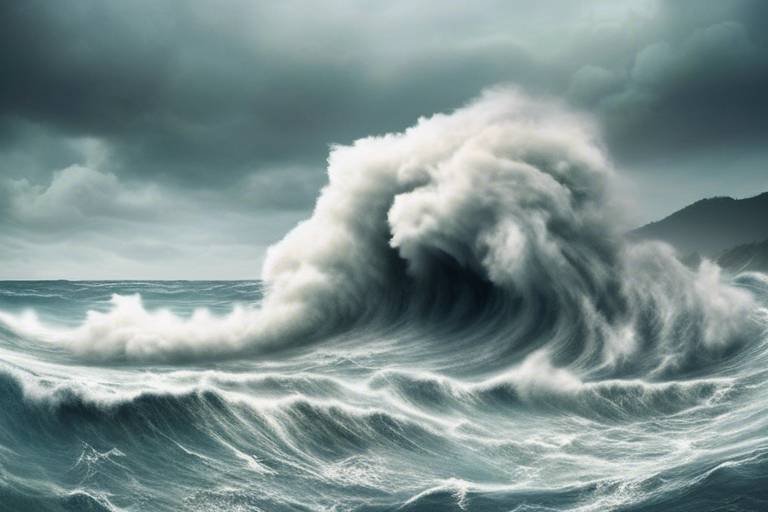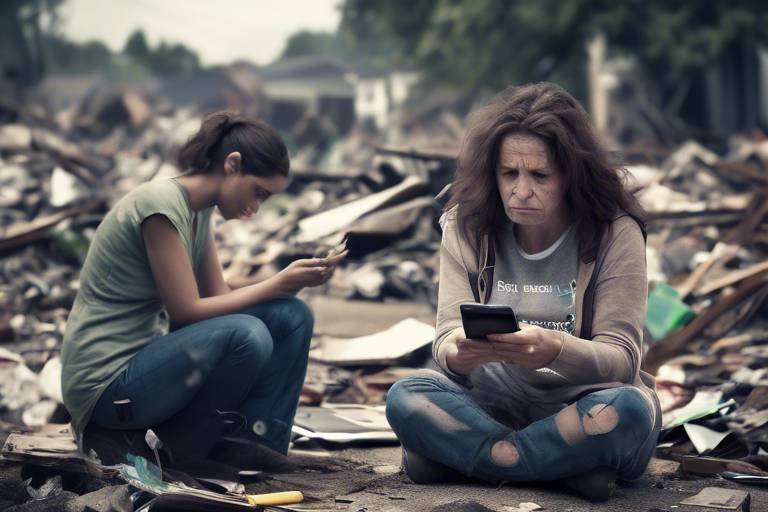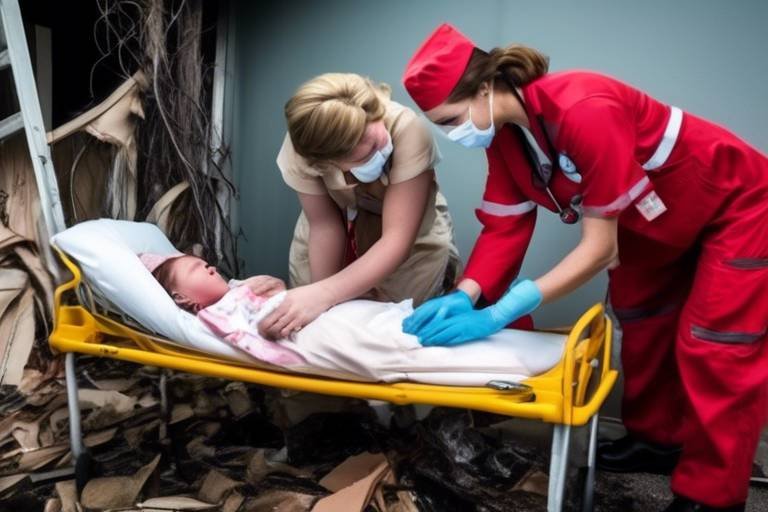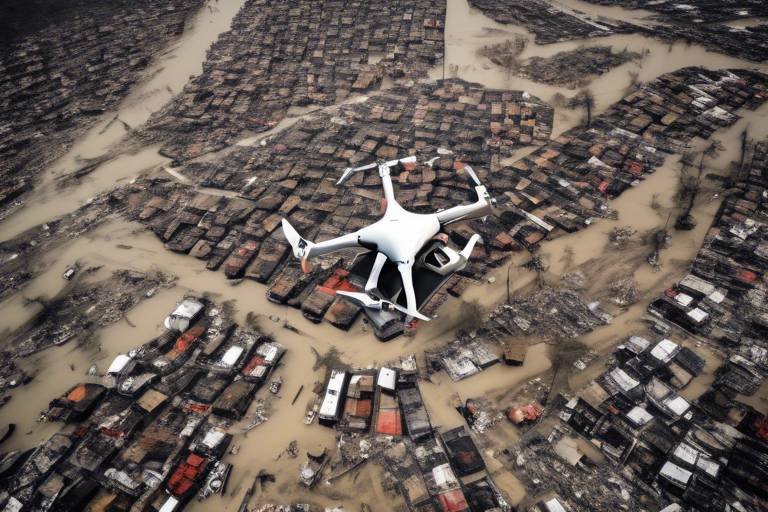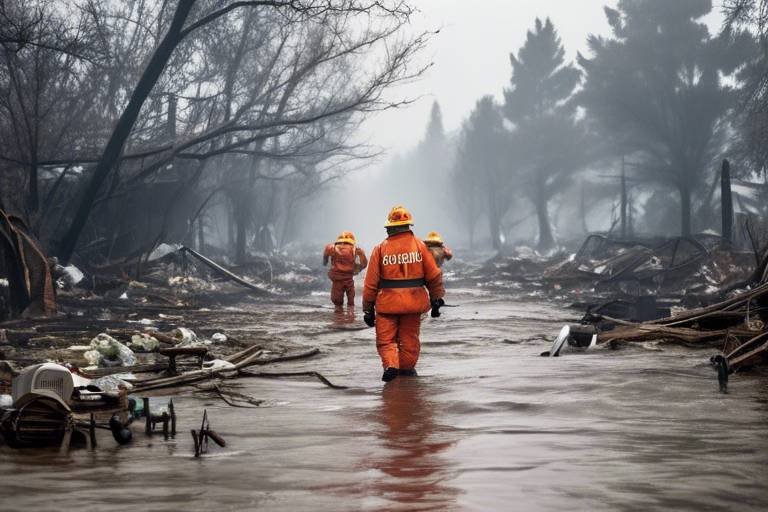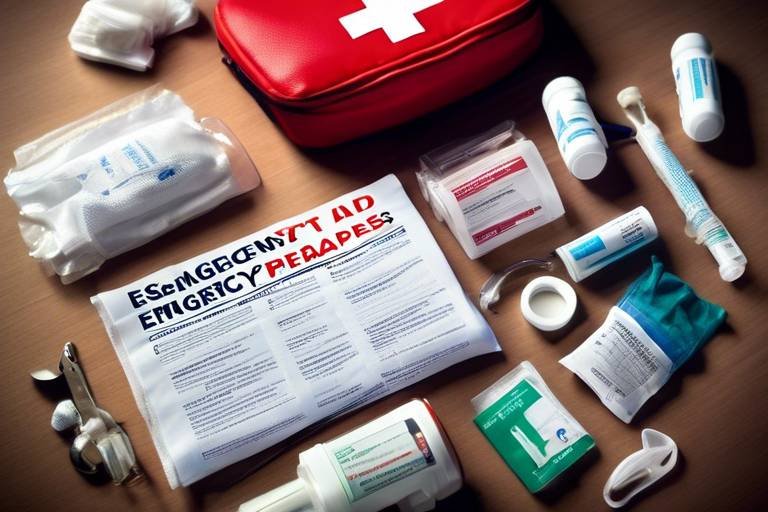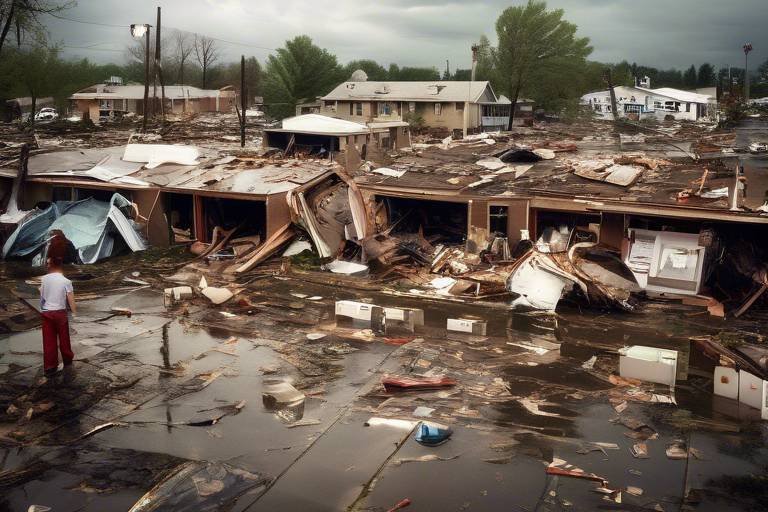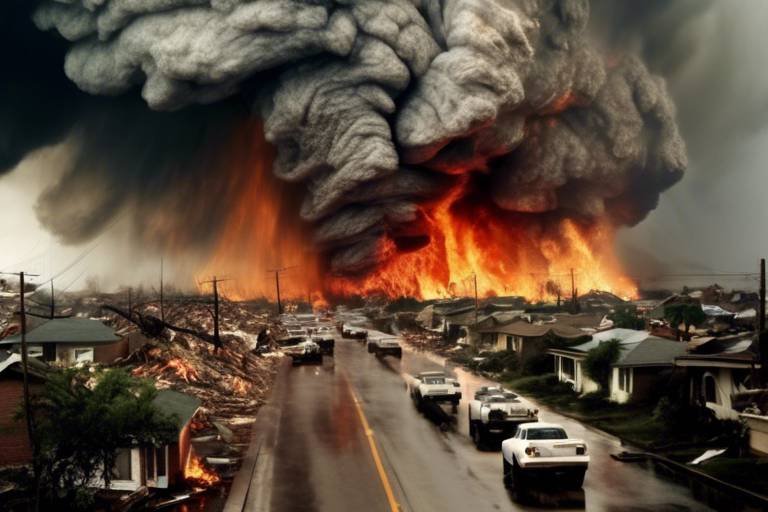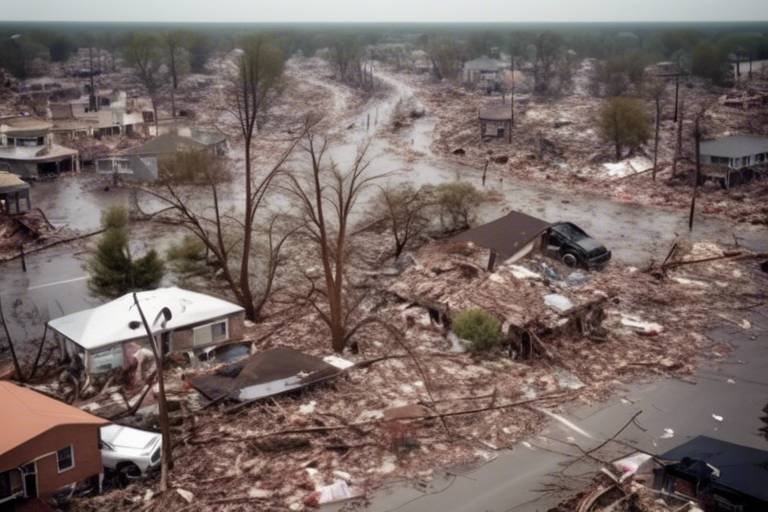Surviving a Tsunami - A Comprehensive Guide
Tsunamis are among the most powerful natural disasters, capable of wreaking havoc on coastal communities in mere moments. Understanding how to prepare for, respond to, and recover from such catastrophic events is crucial for ensuring safety and resilience. This guide aims to equip you with essential knowledge and practical steps to take before, during, and after a tsunami strikes. By familiarizing yourself with these steps, you can significantly reduce risks and enhance your chances of survival.
Tsunamis are not just big waves; they are a series of ocean waves caused by underwater disturbances, such as earthquakes, volcanic eruptions, or landslides. When these disturbances occur, they displace a massive amount of water, creating waves that can travel across entire ocean basins at speeds of up to 500 miles per hour. As these waves approach shallow coastal waters, they can grow in height, sometimes reaching over 100 feet! Understanding the formation and characteristics of tsunamis is vital to grasp their potential impact and how to respond effectively.
Preparation is key to survival in the face of a tsunami. It’s not just about having a plan; it’s about being proactive. To ensure you and your loved ones are ready, start by creating a comprehensive tsunami emergency plan. This includes identifying evacuation routes, assembling emergency kits, and establishing communication strategies. Remember, the time to prepare is before a tsunami warning is issued, not during the chaos that follows.
Developing a robust emergency plan is crucial. This plan should clearly outline roles for each family member, identify safe zones, and ensure everyone understands what to do in the event of a tsunami. Consider conducting regular drills to keep everyone familiar with the procedures. The more prepared you are, the more confident you’ll feel when disaster strikes.
Knowing the best evacuation routes can mean the difference between life and death. Identify and practice these routes ahead of time, focusing on areas that lead to high ground and safe locations away from the coast. Make sure to have a map handy and discuss these routes with your family. It’s also wise to check for any local signage that indicates evacuation paths.
An emergency kit is vital for survival. Your kit should include essential items, such as:
- Non-perishable food and water (at least a three-day supply)
- First aid supplies
- Flashlights and batteries
- Important documents (insurance papers, identification)
- Clothing and personal hygiene items
Having these items ready can provide peace of mind and ensure you’re equipped to handle the aftermath of a tsunami.
During a tsunami warning, staying informed is essential. Make sure you have access to reliable sources for real-time updates. This could include weather alerts, local news, and emergency services. Consider downloading emergency apps that can send notifications directly to your phone. The more informed you are, the better equipped you’ll be to act swiftly and safely.
Knowing what to do during a tsunami can make a significant difference. If a tsunami warning is issued, it’s crucial to take immediate action. Recognizing warning signs and following evacuation procedures can save lives. Always remember that time is of the essence, and hesitation can lead to dire consequences.
Recognizing the signs of an impending tsunami is crucial. Natural indicators include:
- Strong earthquakes
- Sudden changes in ocean behavior, such as rapid water receding
- Official alerts from local authorities
If you notice any of these signs, don’t wait for an official warning—evacuate immediately!
Following proper evacuation procedures can save lives. Move to higher ground and avoid coastal areas. If you are in a boat, head out to sea, as the waves are often less severe in deeper water. Stay away from river mouths, as they can funnel tsunami waves inland.
The aftermath of a tsunami can be devastating. Assessing damage, seeking assistance, and participating in community rebuilding efforts are vital steps in the recovery process. It’s essential to have a plan for what to do once the immediate danger has passed.
Assessing damage is critical for recovery. Once it’s safe to return, carefully evaluate your property and personal losses. Document all damage for insurance claims and future planning. Remember to take photos and make lists to ensure you have a comprehensive record of what was lost.
Community support plays a vital role in recovery. Local organizations and volunteer efforts can make a huge difference in rebuilding efforts. Engage with your neighbors and participate in community initiatives to help restore normalcy. Together, we can rebuild and come back stronger.
Q: What should I do if I feel an earthquake?
A: If you feel an earthquake, move to higher ground immediately, especially if you live in a coastal area.
Q: How can I prepare my family for a tsunami?
A: Create an emergency plan, practice evacuation routes, and assemble an emergency kit with essential supplies.
Q: Where can I get real-time tsunami alerts?
A: Stay informed through local news, weather alerts, and emergency services apps.
Q: What are the signs of a tsunami?
A: Signs include strong earthquakes, unusual ocean behavior, and official alerts.
Q: How can I help my community recover after a tsunami?
A: Volunteer with local organizations and participate in rebuilding efforts to support your community.

Understanding Tsunamis
Tsunamis are not just big waves; they are **powerful ocean disturbances** that can wreak havoc on coastlines and communities. Often triggered by underwater earthquakes, volcanic eruptions, or landslides, these colossal waves can travel across entire ocean basins at incredible speeds, sometimes exceeding 500 miles per hour. To truly appreciate the impact of a tsunami, it’s essential to understand how they form, their characteristics, and the science behind these natural disasters.
The formation of a tsunami typically begins with a sudden displacement of water. This can occur when tectonic plates shift during an earthquake, creating a vertical movement of the seafloor. The energy released from this movement generates waves that propagate outward in all directions. Unlike regular ocean waves, which are caused by wind and only affect the surface, tsunami waves can reach depths of several hundred meters. As they approach shallower coastal waters, their speed decreases, but their height can increase dramatically, leading to the towering waves that can crash onto land with devastating force.
One of the most striking characteristics of tsunamis is their **long wavelength**; they can stretch for hundreds of miles. This means that, while the waves may not be very tall in deep water, they can gather height as they approach the shore. For example, when a tsunami reaches the coastline, it can rise to heights of over 100 feet, depending on the underwater topography and the energy of the wave. The sheer power of these waves can lead to catastrophic flooding, destroying infrastructure, homes, and entire communities.
To better grasp the potential impact of tsunamis, it’s helpful to look at some key facts:
- Speed: Tsunami waves can travel as fast as a commercial jet in deep water.
- Height: The height of tsunami waves can vary significantly, with some reaching over 100 feet.
- Frequency: Tsunamis can occur multiple times a year, but significant events are less common.
- Warning time: Depending on the location, warning time can range from minutes to several hours.
Understanding the science behind tsunamis not only enhances our knowledge but also prepares us for the potential threats they pose. By recognizing the warning signs and the conditions that lead to their formation, we can better equip ourselves to respond effectively. It’s crucial to stay informed and to understand that while tsunamis are natural phenomena, their impact can be mitigated through preparation and awareness. In the next sections, we will delve into practical steps for preparing for a tsunami and ensuring safety for ourselves and our loved ones.
What causes a tsunami?
Tsunamis are primarily caused by underwater earthquakes, volcanic eruptions, or landslides that displace large amounts of water.
How can I prepare for a tsunami?
Preparation includes creating an emergency plan, identifying evacuation routes, and assembling an emergency kit with essential supplies.
What should I do if I feel an earthquake?
If you feel an earthquake, especially in coastal areas, move to higher ground immediately as this could indicate a tsunami is imminent.

Preparing for a Tsunami
Preparation is key to survival when it comes to natural disasters like tsunamis. You might think that living in a coastal area means you're safe from these massive waves, but the truth is, anyone near the ocean should be aware of the potential threat. It's not just about knowing what to do when a tsunami warning is issued; it's about being proactive and having a solid plan in place long before disaster strikes. Imagine being caught off guard, scrambling to find your loved ones, or worse, not knowing where to go. It’s a nightmare scenario that can be avoided with a little foresight and preparation.
The first step in preparing for a tsunami is to develop a comprehensive emergency plan. This plan should outline specific roles for each family member, ensuring everyone knows what to do when the time comes. For instance, designate a family member to grab the emergency kit, while another is responsible for gathering pets. It’s all about teamwork, right? Additionally, you should identify safe zones—areas that are on higher ground and away from the coast. Make sure everyone in your household understands these locations and practices the routes to them.
Creating an emergency plan can feel overwhelming, but it doesn’t have to be. Start by sitting down with your family and discussing potential scenarios. Ask questions like, “What would we do if a tsunami warning was issued right now?” or “Where would we meet if we got separated?” This discussion will help everyone feel more secure and informed. Once you’ve established roles and safe zones, write everything down. Having a physical copy of your emergency plan can serve as a helpful reminder during a stressful situation.
Knowing the best evacuation routes can literally save lives. It’s essential to identify these routes ahead of time and practice them regularly. This isn't just about knowing the fastest way to get to higher ground; it’s also about understanding the terrain and being aware of any potential obstacles you might face during an evacuation. You could even create a visual map and place it in a common area of your home. This way, everyone can familiarize themselves with the routes. Remember, when the sirens sound, there won’t be time for second-guessing!
An emergency kit is vital for survival during a tsunami. Think of it as your lifeline when chaos ensues. What should you include in this kit? Well, here’s a quick checklist to consider:
- Water: At least one gallon per person per day for three days.
- Food: Non-perishable items that can last for at least three days.
- First Aid Supplies: Bandages, antiseptics, and any necessary medications.
- Important Documents: Copies of identification, insurance policies, and any critical medical information.
- Flashlight and Batteries: Power outages are common after disasters.
Keep your emergency kit in a readily accessible location, and make sure that all family members know where it is. Regularly check and update the contents, replacing expired food and medications as needed. This simple act can make a world of difference when disaster strikes.
Staying informed during a tsunami warning is crucial. You can’t prepare if you don’t know what’s happening! Make it a habit to monitor local news channels, weather alerts, and emergency services updates. Many communities also have alert systems that send texts or emails during emergencies. Sign up for these alerts so you can be one step ahead. Think of it as having a lifeguard watching over you while you swim—it's all about safety and awareness!
By taking these preparation steps seriously, you’re not just safeguarding yourself; you're also protecting your loved ones and your community. It’s like building a fortress against the unpredictability of nature. So, roll up your sleeves, gather your family, and start planning today. Your future self will thank you!
Q: What should I do if I receive a tsunami warning?
A: Immediately follow your emergency plan, evacuate to higher ground, and stay away from the coast. Listen to local authorities for updates.
Q: How can I stay informed about tsunami risks?
A: Monitor local news, sign up for emergency alerts, and follow weather channels for real-time updates.
Q: What items are essential in an emergency kit?
A: Your kit should include water, non-perishable food, first aid supplies, important documents, and a flashlight with batteries.
Q: How often should I check my emergency kit?
A: Regularly check your kit at least twice a year to replace expired items and ensure everything is in working order.

Creating an Emergency Plan
Creating a comprehensive emergency plan is not just a good idea; it's a necessity when it comes to surviving a tsunami. Imagine standing on the shore, feeling the ground tremble beneath your feet. In those moments, having a well-thought-out plan can mean the difference between safety and disaster. Start by gathering your family and discussing the potential risks and necessary actions. It’s essential that everyone knows their role and understands the plan. This way, panic can be minimized, and decisive action can be taken swiftly.
One of the first steps in creating your emergency plan is to identify safe zones. These are locations that are high enough to be out of reach of tsunami waves. Think about places like hills or designated evacuation centers. Share these locations with your family and even practice getting there. It’s like a fire drill, but for a tsunami! The more familiar everyone is with the route, the quicker you can move when the time comes.
Communication is another critical component of your emergency plan. In the chaos of a tsunami warning, cell phones might not work, and power outages can happen. Establishing a meeting point where everyone can gather after evacuating is vital. Additionally, consider designating an out-of-town contact person. This person can help relay messages and keep everyone informed about each other’s safety. It’s like having a lifeline when everything else seems uncertain.
Don't forget to prepare an emergency kit! This kit should include essential items that can sustain you and your family for at least 72 hours. Think about including:
- Non-perishable food and bottled water
- First aid supplies
- Flashlights and batteries
- Important documents like insurance policies and identification
- A battery-powered or hand-crank radio for updates
Store these supplies in an easily accessible location, and make sure everyone knows where to find them. Regularly check and update the contents of your emergency kit to ensure that everything is in working order and not expired. In essence, your emergency plan should be a living document that evolves as your family grows and changes.
Finally, remember that practice makes perfect. Hold regular drills to ensure that everyone knows what to do and where to go. This will not only build confidence but also foster a sense of teamwork among family members. In the face of a tsunami, having a well-rehearsed plan can provide a sense of control and peace of mind, allowing you to focus on what truly matters—keeping your loved ones safe.
Q: What should I do if I feel an earthquake?
A: If you feel an earthquake, move to higher ground immediately, as it could indicate a tsunami is on the way.
Q: How can I stay informed about tsunami warnings?
A: Stay tuned to local news, weather alerts, and emergency services for real-time updates on tsunami warnings.
Q: How often should I update my emergency kit?
A: You should check and update your emergency kit at least once a year or whenever there are changes in your family’s needs.

Evacuation Routes
When it comes to surviving a tsunami, knowing your can be the difference between safety and disaster. Imagine you’re at the beach, enjoying the sun, and suddenly you feel the ground shake beneath your feet. Your heart races as you realize that a tsunami could be on its way. What do you do? The first step is to have a solid understanding of where to go. Evacuation routes should be clearly marked and easily accessible, leading you to higher ground away from the coast. It’s not just about knowing the route; it's about practicing it. Just like a fire drill in school, you need to familiarize yourself with the path you’ll take when the alarm goes off.
To effectively prepare, consider mapping out your evacuation routes in advance. This means checking local resources, such as city planning websites or community safety bulletins, to find the safest paths. But don't stop there! Walk through these routes with your family. Make it a fun outing! This will not only help everyone remember the way but also ease any anxiety that might arise in an emergency. Think of it as a treasure hunt, where the treasure is your safety!
In addition to personal practice, keep an eye on local signage. Many coastal areas have designated evacuation signs that can guide you in the event of a tsunami. Here are a few tips to keep in mind:
- Know Your Surroundings: Familiarize yourself with the terrain. Are there hills or buildings that can serve as safe spots?
- Stay Updated: Follow local news and weather reports. They often provide real-time updates on tsunami warnings and evacuation routes.
- Have a Backup Plan: In case your primary route is blocked, identify alternative paths to safety.
Moreover, it’s essential to communicate your evacuation plan with family and friends. Everyone should know where to go and how to get there. In times of panic, having a clear plan can prevent chaos. Consider setting up a meeting point outside of your immediate neighborhood. This way, if you get separated, you know where to regroup. It's like having a safety net in case things go sideways.
Lastly, don't forget about the importance of community resources. Local authorities often conduct drills and provide information on evacuation routes. Participating in these community efforts not only boosts your own preparedness but also strengthens the safety of your entire neighborhood. Remember, in the face of a tsunami, we are stronger together!

Emergency Kits
When it comes to surviving a tsunami, having an emergency kit ready can mean the difference between chaos and calm. Imagine being caught off guard, with only moments to spare before the waves come crashing in. The last thing you want is to scramble around, trying to gather essential supplies. Instead, being prepared with a well-stocked emergency kit can provide you and your loved ones with the necessary tools to navigate through this crisis. So, what should you include in your emergency kit?
Your emergency kit should contain a variety of items that cater to immediate needs, ensuring you have everything you might require for at least 72 hours. The essentials can be grouped into a few categories:
- Food and Water: Pack non-perishable food items such as energy bars, canned goods, and dried fruits. Don't forget to include at least one gallon of water per person per day.
- First Aid Supplies: A well-stocked first aid kit is crucial. Ensure it contains bandages, antiseptic wipes, pain relievers, and any personal medications you may need.
- Important Documents: Keep copies of your identification, insurance policies, and medical records in a waterproof container. This can save you a lot of hassle during recovery.
- Clothing and Blankets: Include a change of clothes, sturdy shoes, and a thermal blanket to keep warm in case you find yourself outdoors.
In addition to these basics, consider adding items that are specific to your family's needs. For instance, if you have infants, pack baby formula and diapers. If you have pets, include food and supplies for them as well. It's also wise to think about entertainment; a deck of cards or a book can help keep spirits up during stressful times.
It's not enough to just assemble these items; you must also regularly check and update your emergency kit. Food can expire, batteries can die, and medications may change. Make it a habit to review your kit every six months, ensuring everything is in good condition and ready for action. You might even consider involving your family in this process, turning it into a fun activity that emphasizes the importance of preparedness.
Lastly, don’t forget to create a communication plan. Include a list of emergency contacts and a portable charger for your phone. In times of crisis, staying connected can be vital, whether it's for receiving updates or reaching out to loved ones.
By taking these steps to prepare your emergency kit, you can significantly enhance your chances of staying safe and resilient in the face of a tsunami. Remember, preparedness is not just about having supplies; it's about fostering a mindset of readiness that can empower you and your family when it matters most.
Q: How often should I check my emergency kit?
A: It's recommended to check your emergency kit every six months to ensure all items are up-to-date and in good condition.
Q: What should I do if I have specific medical needs?
A: Include a sufficient supply of any necessary medications in your emergency kit and consult with your healthcare provider for additional recommendations.
Q: Can I store my emergency kit in the garage?
A: It's best to keep your emergency kit in a cool, dry place that is easily accessible, rather than in a garage where temperatures can fluctuate.

Staying Informed
When a tsunami warning is issued, is not just important; it’s absolutely essential for your safety and survival. The chaos that can ensue during such natural disasters can be overwhelming, but having access to reliable information can significantly improve your chances of making the right decisions. So, how do you ensure you’re in the know when every second counts?
First and foremost, consider subscribing to local weather alerts. Many regions prone to tsunamis offer real-time notifications via text messages or emails. These alerts can provide crucial information about the status of the tsunami, including its expected arrival time and potential impact areas. Don’t wait until the last minute; sign up for these services in advance to ensure you’re always plugged in.
Additionally, keeping an eye on local news channels can be a game-changer. Television and radio broadcasts often provide more detailed updates than social media, which can sometimes be unreliable during emergencies. Tune into local stations for continuous coverage, and don’t hesitate to switch on your battery-operated radio if the power goes out. Remember, information is power, and being informed can help you make swift and informed decisions.
Another key source of information is your local emergency services. Many towns and cities have dedicated websites or social media pages that offer updates during emergencies. These platforms can provide not only real-time alerts but also guidance on evacuation routes, shelters, and safety measures. Make it a habit to check these resources regularly, especially if you live in a tsunami-prone area.
Lastly, consider joining community groups or forums focused on disaster preparedness. Engaging with others who share your concerns can be incredibly beneficial. You can exchange tips, share resources, and stay updated on local preparedness initiatives. Plus, you might just find a neighbor who has firsthand experience and valuable insights to share!
In summary, staying informed during a tsunami warning involves a combination of subscribing to alerts, tuning into local news, following emergency services, and connecting with your community. By taking these proactive steps, you’ll not only enhance your safety but also empower yourself and those around you to respond effectively when it matters most.
- What should I do if I receive a tsunami warning? Immediately evacuate to higher ground and follow your emergency plan.
- How can I prepare my family for a tsunami? Create an emergency plan, identify evacuation routes, and assemble an emergency kit.
- What are the natural signs of a tsunami? Look for strong earthquakes, unusual ocean behavior, or a sudden retreat of water from the shore.
- How can I stay updated during a tsunami? Subscribe to weather alerts, monitor local news, and check emergency services' websites.

During a Tsunami
Knowing what to do during a tsunami can make a significant difference between life and death. When a tsunami warning is issued, the clock is ticking, and your response time is crucial. It's essential to stay calm and act quickly. Remember, the first step in ensuring your safety is to trust your instincts and follow established emergency protocols. Panic can cloud judgment, so take a deep breath and focus on the actions you need to take.
One of the most critical aspects of surviving a tsunami is recognizing the warning signs. Natural indicators can often provide the first clues that a tsunami may be imminent. For instance, if you experience a strong earthquake, it’s vital to be alert. Earthquakes are often the precursor to tsunamis. Additionally, if you notice an unusual retreat of the ocean—where the water suddenly pulls back from the shore—this is a clear sign that a tsunami is on its way. In such cases, you should immediately move to higher ground without waiting for official warnings.
Official alerts can come from various sources, including local news channels, weather apps, and emergency services. It’s important to stay tuned to these channels for real-time updates. If you hear a tsunami warning siren, don't hesitate; evacuate immediately. Remember, the ocean can be unpredictable, and the first wave may not be the largest. Subsequent waves can be even more powerful, so getting to safety as quickly as possible is essential.
When it comes to evacuation procedures, having a plan in place can save lives. If you are in a tsunami-prone area, familiarize yourself with the evacuation routes before disaster strikes. These routes should lead you to higher ground or designated safe zones. Practice these routes with your family, ensuring that everyone knows how to get to safety. In the chaos that follows a tsunami warning, having a practiced plan can mean the difference between safety and tragedy.
While evacuating, it's crucial to avoid coastal areas and not to return until authorities declare it safe. Many people make the mistake of wanting to witness the waves or check on property, but this can be extremely dangerous. Instead, focus on reaching a safe location and staying there until the danger has passed. If you're in a vehicle, avoid driving through flooded areas, as even a small amount of water can sweep a car away. If you find yourself trapped, seek higher ground on foot.
In the aftermath of a tsunami, the landscape can change dramatically, and hazards may be present. Stay informed through official channels about the situation and any further risks. Remember, your safety is the top priority, and it’s okay to seek help if you need it. The community will come together to support each other during this challenging time.
- What should I do if I feel an earthquake? If you feel a strong earthquake, immediately move to higher ground, as this could indicate a tsunami is coming.
- How can I stay informed during a tsunami warning? Use local news, weather apps, and emergency services for real-time updates and instructions.
- Is it safe to go back to the beach after a tsunami warning is lifted? No, it's important to wait for authorities to declare it safe before returning to coastal areas.

Recognizing Warning Signs
When it comes to tsunamis, being able to recognize the warning signs can be the difference between life and death. Imagine standing on the beach, enjoying the beautiful ocean view, when suddenly, the ground shakes beneath your feet. This is often the first and most crucial warning sign of an impending tsunami. Earthquakes, especially those that occur under the ocean, can trigger massive waves that travel at incredible speeds. If you feel a strong tremor, it’s essential to take it seriously and prepare for potential evacuation.
Another significant indicator of a tsunami is the behavior of the ocean itself. Have you ever noticed the water suddenly receding far beyond the normal low tide? This phenomenon, often referred to as "drawback," can signal that a tsunami is on its way. It’s a startling sight; the ocean seems to be pulling back, exposing the sea floor and leaving fish flopping helplessly on the sand. If you witness this, it's crucial to move to higher ground immediately, as the tsunami will soon follow.
In addition to natural indicators, official alerts play a vital role in tsunami readiness. The National Oceanic and Atmospheric Administration (NOAA) and local emergency services issue tsunami warnings that can save lives. These alerts come through various channels, including:
- Emergency Alert System (EAS)
- NOAA Weather Radio
- Mobile alerts and notifications
- Local news broadcasts
It’s important to stay tuned to these sources, especially if you live in coastal areas prone to tsunamis. Having a battery-powered radio or a smartphone with emergency alert capabilities can be a lifesaver. Remember, when a warning is issued, don’t wait for more signs; act quickly! Your safety is paramount, and knowing how to recognize these warning signs can help ensure that you and your loved ones are prepared to respond effectively.
In summary, recognizing the warning signs of a tsunami involves being aware of seismic activity, observing unusual ocean behavior, and staying informed through official alerts. By paying attention to these signals, you can take proactive steps to safeguard your life and the lives of those around you. Always err on the side of caution; if you suspect a tsunami is coming, evacuate to higher ground and stay there until authorities declare it safe to return.
Q: What should I do if I feel an earthquake while at the beach?
A: If you feel an earthquake, especially if it’s strong, evacuate immediately to higher ground. Do not wait for an official tsunami warning.
Q: How can I stay informed about tsunami warnings?
A: Keep a battery-powered radio, sign up for local alert systems, and follow NOAA and local news channels for real-time updates.
Q: What are the best evacuation routes during a tsunami?
A: Familiarize yourself with local evacuation routes that lead to high ground. Practice these routes with your family to ensure everyone knows where to go.
Q: How long do I need to stay away from the coast after a tsunami warning?
A: Stay away until local authorities declare it safe to return. Tsunamis can occur in multiple waves, and the first one is not always the largest.

Evacuation Procedures
When a tsunami warning is issued, knowing the proper can be a matter of life and death. The first thing to remember is to stay calm and act quickly. Panic can cloud judgment, so take a deep breath and focus on the steps you need to take. Your primary goal is to move to higher ground or a designated safe area, away from the coast. But how do you ensure that you're evacuating effectively?
One of the key aspects of an effective evacuation is having a well-thought-out plan. This plan should include designated evacuation routes that are clear and easily accessible. Familiarize yourself with these routes before a disaster strikes. You might even consider practicing the routes with your family to ensure everyone knows where to go. Remember, the safest places are usually those that are at least 100 feet above sea level or two miles inland from the coastline.
In the event of a tsunami, the first sign that evacuation is necessary may be an official alert or warning. However, nature often provides its own warning signs. If you experience a strong earthquake, feel the ground shake, or notice the ocean suddenly receding, these are indicators that a tsunami may be on its way. In such cases, do not wait for official confirmation; evacuate immediately.
Once you've decided to evacuate, it's crucial to follow these :
- Grab your emergency kit, which should be packed with essential supplies.
- Inform family members of your plan and ensure everyone is accounted for.
- Use your pre-planned evacuation routes; avoid roads that may be flooded or blocked.
- Stay tuned to local news or emergency services for real-time updates as you evacuate.
While evacuating, keep in mind that time is of the essence. Do not attempt to gather valuables or possessions; your safety is far more important than material items. Also, avoid the temptation to stay and watch the waves. Tsunamis can arrive minutes after the initial earthquake, and the first wave is often not the largest. Subsequent waves can be even more dangerous, so it’s vital to keep moving.
Once you reach your safe location, stay there until officials declare it safe to return. This could take time, as authorities will need to assess the situation and ensure that the area is no longer at risk. In the meantime, check in with family members and friends to ensure they are safe, and listen for updates on the situation.
In conclusion, effective evacuation procedures can significantly increase your chances of surviving a tsunami. By preparing in advance, staying informed, and acting quickly, you can navigate this natural disaster with confidence and resilience. Remember, it’s not just about knowing where to go, but also about being mentally prepared to act decisively when the time comes.
Q: What should I include in my emergency kit?
A: Your emergency kit should include non-perishable food, water, a flashlight, batteries, a first aid kit, important documents, and any necessary medications.
Q: How can I stay informed during a tsunami warning?
A: Stay tuned to local news stations, weather alerts, and emergency services for real-time updates. Consider downloading emergency apps that provide alerts.
Q: What are the signs that a tsunami may occur?
A: Signs include a strong earthquake, the ocean suddenly receding, or unusual ocean behavior. If you notice any of these signs, evacuate immediately.

After a Tsunami
The aftermath of a tsunami can be a chaotic and heartbreaking time. Once the waves have receded, the reality of the destruction often sets in. Homes, businesses, and entire communities can be left in ruins, and the emotional toll can be just as devastating as the physical damage. It's crucial to approach the recovery process with a clear mind and a plan. Understanding the steps to take can significantly ease the burden of recovery and help individuals and communities start to rebuild their lives.
First and foremost, assessing the damage is essential. This means taking a careful look at your property and surroundings to understand what has been lost or damaged. Safety should be your priority—before entering any structures, check for hazards like gas leaks, downed power lines, or unstable debris. Once you ensure that it’s safe, you can begin documenting the damage for insurance purposes. This documentation should include photographs and detailed notes about what was lost or damaged, as this will be vital when you file claims.
In addition to individual recovery, community support plays a vital role in the healing process. After a tsunami, it's common to see neighbors helping neighbors, and local organizations stepping up to provide assistance. Engaging with these community efforts not only aids in recovery but also fosters a sense of unity and resilience. Consider volunteering your time or resources to local recovery initiatives. This can include everything from helping to clean up debris to participating in fundraising efforts for those who have lost everything.
Moreover, it's important to seek assistance from local authorities and organizations that specialize in disaster recovery. They can provide resources and guidance on how to navigate the recovery process effectively. Many communities set up recovery centers that serve as hubs for information and support, where you can find everything from food and shelter to counseling services.
Lastly, remember that recovery is not just about rebuilding physical structures; it's also about emotional healing. The psychological impact of experiencing a tsunami can linger long after the waters have receded. Don't hesitate to reach out for help if you or someone you know is struggling. Local mental health services often ramp up their support during recovery efforts, providing counseling and therapy to help individuals cope with their experiences.
In summary, the journey after a tsunami is undoubtedly challenging, but with the right approach and support, communities can recover and rebuild stronger than before. Embrace the power of community, utilize available resources, and take care of your mental health as you navigate this difficult time.
- What should I do immediately after a tsunami? Assess your surroundings for safety, document any damages, and connect with local recovery efforts.
- How can I help my community recover? Volunteer your time, donate resources, and participate in local rebuilding initiatives.
- What resources are available for mental health support after a disaster? Many local organizations offer counseling services specifically for disaster survivors; check with community centers for information.
- How can I prepare for future tsunamis? Create an emergency plan, stay informed about evacuation routes, and maintain an emergency kit.

Assessing Damage
After the chaos of a tsunami, the first step towards recovery is assessing the damage. This process not only helps you understand the extent of destruction but also aids in planning the next steps for recovery. Imagine standing in your home, looking at the aftermath of nature's fury, and feeling overwhelmed. It's crucial to approach this situation methodically to regain a sense of control.
Start by ensuring your safety and the safety of others around you. Before entering any damaged structures, check for hazards such as gas leaks, downed power lines, or unstable debris. Once it's safe to proceed, you can begin your assessment. Take your time to thoroughly evaluate your property, both inside and out.
While assessing damage, it’s beneficial to document everything. Use your smartphone or a camera to take pictures of the destruction. This will not only provide a visual record for insurance claims but also help in future planning. Create a comprehensive list of damaged items and structures, noting their condition. This can include:
- Structural damages to your home
- Damaged personal belongings
- Landscaping and outdoor structures
- Utilities that need repair or replacement
Once you’ve documented the damage, it’s time to categorize your findings. You might find it helpful to create a simple damage assessment table like the one below:
| Item/Area | Condition | Estimated Repair Cost |
|---|---|---|
| Roof | Severe Damage | $5,000 |
| Living Room Furniture | Waterlogged | $1,200 |
| Garage | Completely Destroyed | $3,000 |
This table serves as a clear reference for your insurance provider and can help streamline the claims process. Remember, the more detailed your documentation, the better your chances of receiving adequate compensation.
Lastly, don’t hesitate to reach out for help. Local authorities, community organizations, and disaster relief agencies often provide resources and support for those affected. They can assist in navigating the recovery process, from financial aid to rebuilding efforts. By engaging with these resources, you not only support your recovery but also contribute to the community's resilience.

Community Support
Community support is an absolute lifeline in the aftermath of a tsunami. When the waves recede and the dust begins to settle, it’s the strength of the community that often shines the brightest. Imagine a neighborhood where everyone comes together, pooling resources and sharing hope. This is the essence of community support, where individuals unite to help rebuild not just homes, but lives.
In the wake of disaster, local organizations, volunteers, and even strangers become instrumental in providing the necessary assistance to those affected. From distributing food and water to offering emotional support, these community efforts play a vital role in recovery. It’s not just about physical rebuilding; it’s also about restoring a sense of normalcy and connection. After all, when people feel supported, they are more likely to recover mentally and emotionally, which is just as crucial as repairing structures.
One of the most effective ways communities can provide support is through organized relief efforts. These can include:
- Food Drives: Collecting non-perishable food items to help those who may have lost everything.
- Clothing Donations: Providing clothing and personal items that may have been lost during the disaster.
- Rebuilding Projects: Mobilizing volunteers to help rebuild homes and community facilities.
- Emotional Support Services: Offering counseling and support groups to help individuals process their experiences.
Moreover, community support extends beyond immediate relief. It involves long-term strategies for resilience and preparedness. By engaging in community planning sessions, residents can work together to develop better emergency response strategies and ensure that everyone knows how to act when disaster strikes again. This proactive approach not only strengthens the community but also fosters a sense of belonging and shared responsibility.
Finally, it’s essential to recognize that community support is a two-way street. While those affected by the tsunami need help, it’s equally important for volunteers and supporters to take care of themselves. Burnout can be a real issue for those giving their time and energy, so self-care and mental health resources should also be prioritized. By supporting each other, communities can emerge stronger, more resilient, and more connected than ever.
Q: How can I help my community after a tsunami?
A: You can help by volunteering with local organizations, donating supplies, or participating in community rebuilding efforts. Every little bit counts!
Q: What resources are available for emotional support?
A: Many organizations offer counseling services for disaster survivors. Check with local mental health services or community centers for resources.
Q: How can communities prepare for future tsunamis?
A: Communities can prepare by developing emergency plans, conducting drills, and educating residents about tsunami risks and safety measures.
Frequently Asked Questions
- What causes a tsunami?
A tsunami is typically caused by underwater disturbances, such as earthquakes, volcanic eruptions, or landslides. These events displace a large volume of water, creating powerful waves that can travel across oceans at high speeds.
- How can I prepare for a tsunami?
Preparation is key! Start by creating an emergency plan that includes evacuation routes to higher ground, assembling an emergency kit with essential supplies, and ensuring that all family members are familiar with the plan. Regularly practice your evacuation routes to make sure everyone knows what to do.
- What should I include in my emergency kit?
Your emergency kit should contain at least three days' worth of non-perishable food, water, a first aid kit, flashlights, batteries, important documents, and any necessary medications. Don’t forget to include items for pets if you have them!
- How can I stay informed during a tsunami warning?
Stay tuned to local news updates, weather alerts, and emergency services notifications. Consider downloading apps that provide real-time alerts about natural disasters in your area to keep yourself and your loved ones informed.
- What should I do if I feel an earthquake?
If you feel an earthquake, move to higher ground immediately after the shaking stops. Tsunamis can follow earthquakes without much warning, so it’s crucial to act quickly and avoid coastal areas until you receive confirmation that it’s safe.
- How do I assess damage after a tsunami?
After a tsunami, carefully evaluate your property for damage. Document everything with photos and notes for insurance purposes. Be cautious of hazards like unstable structures or contaminated water, and seek professional help if needed.
- What role does community support play in recovery?
Community support is vital for recovery after a tsunami. Local organizations often mobilize to provide assistance, and volunteer efforts can help rebuild homes and restore normalcy. Getting involved in community programs can foster resilience and unity among affected individuals.

